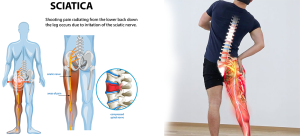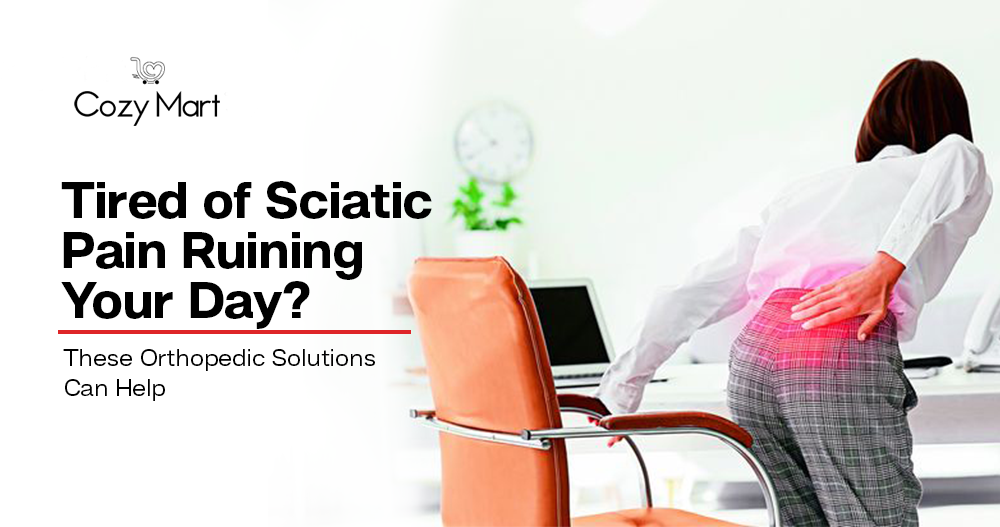Tired of Sciatic Pain Ruining Your Day? These Orthopedic Solutions Can Help
It’s a pain unlike any other.
It’s not just a dull ache; it’s a sharp, shooting, or burning sensation that can feel like an electric jolt. It starts deep in your lower back or buttocks and then… it travels. It zips down your leg, sometimes all the way to your foot, turning simple acts like sitting, standing, or even sleeping into a minefield of discomfort.
This is sciatica, and if you’re reading this, you know it’s not just “a pain in the leg.” It’s a life-disrupting thief. It steals your focus at work, your comfort in the car, and your ability to simply relax.
But here’s the good news: while you should always see a doctor for a proper diagnosis, relief doesn’t have to come from a prescription bottle. For many, the path to managing and reducing this agonizing pain starts with one simple change: how you support your body.
What is Sciatica, Anyway?
In simple terms, sciatica is a symptom, not a diagnosis. The pain is the “check engine” light. It’s your body’s alarm bell screaming that the sciatic nerve, the longest nerve in your body, running from your lower back down each leg, is being pinched, compressed, or irritated.
This “pinch” is often caused by a herniated disc, spinal stenosis, or a tight piriformis muscle (a muscle located deep in the gluteal region). And what’s the number one activity that makes this pinching worse?
You guessed it: sitting.
Sitting: The Sciatica Sufferer’s Worst Enemy
When you sit, especially in a flat, hard, or unsupportive chair, you do two things that your sciatic nerve hates:
- You put direct pressure on your glutes, tailbone, and the nerve itself.
- You cause your pelvis to tilt backward, which flattens your lower back and can cause your discs to bulge backward, directly where the nerve roots are located.
This is why your office chair feels like a torture device and why long drives are a dreaded activity. But since we can’t avoid sitting or sleeping, we have to make those activities smarter.
This is where orthopedic solutions come in. They aren’t a “cure,” but they are an essential part of the solution. They are tools designed to take the pressure off.

The Orthopedic Toolkit for Sciatic Pain Relief
Think of these items as creating an “ecosystem of relief” that protects your nerves from its daily triggers.
1. The Game-Changer: The Coccyx Seat Cushion
If you buy only one thing for your sciatica, make it this. A coccyx cushion (often U-shaped or with a cutout at the back) is brilliantly simple.
- How it works: That small cutout at the back suspends your tailbone (coccyx) in the air. This instantly stops the “shock” that travels up your spine when you sit. More importantly, a high-quality memory foam cushion tilts your pelvis slightly forward, forcing you into a healthier posture.
- Why it helps sciatica: By promoting a healthy sitting posture and removing direct pressure, you’re no longer compressing the nerve roots. It takes the “pinch” out of sitting, allowing the nerve to calm down and heal. It’s the single best way to make your office chair and car seat work for you, not against you.
2. The Slouch-Stopper: The Lumbar Support Pillow
Look at how you’re sitting right now. Is there a gap between your lower back and your chair? If there is, your muscles are working overtime to hold you up. Eventually, they get tired, and you slouch.
Slouching is the arch nemesis of your sciatic nerve.
- How it works: A lumbar support pillow (a roll, D-shape, or full-back cushion) fits into that gap, providing firm, constant support to the natural curve of your lower back.
- Why it helps sciatica: It makes it physically difficult to slouch. This keeps your spine in proper alignment, preventing your vertebrae from compressing the nerve. When paired with a coccyx cushion, it creates the ultimate supported-sitting environment.
3. The Nighttime Savior: The Knee Pillow
Sciatica doesn’t just clock out at 5 PM. For side sleepers, the night can be a long battle. When you lie on your side, your top leg naturally falls forward and down. This seems harmless, but it has a devastating effect: it twists your pelvis and lower back, putting your spine in a compromised, strained position for 8 hours.
- How it works: An ergonomically shaped knee pillow is placed between your knees and/or thighs. It’s made of firm foam that holds its shape.
- Why it helps sciatica: It keeps your top leg perfectly aligned with your hip. This locks your pelvis and spine into a neutral, straight position, preventing that nightly twisting and relieving the stress on your sciatic nerve. The result is often waking up with dramatically less pain and stiffness.
(For back sleepers: A wedge pillow placed under your knees accomplishes the same thing by flattening your lumbar spine and opening up the nerve pathways.)
It’s Time to Get Your Day Back
You don’t have to “just live with” sciatic pain. You don’t have to wince every time you stand up or dread a long car ride.
While stretching and medical advice are key, these orthopedic solutions are the missing link. They are the 24/7 support system your body needs to finally heal. By simply changing the way you sit, drive, and sleep, you can take control of your pain and get back to living your life.
Ready to stop wincing and start living?
Visit our shop to Explore Our Collection of Orthopedic Solutions for Sciatica Relief!



Comments